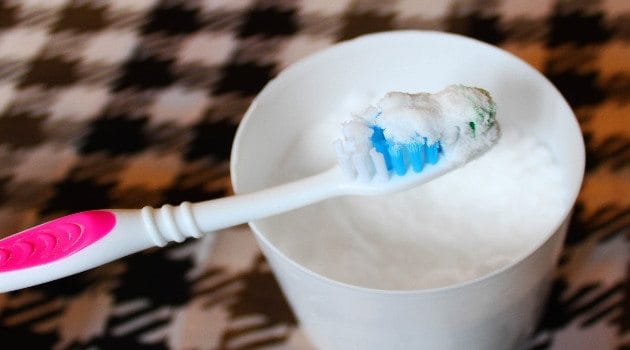It’s the million-dollar question every dental expert gets asked every day – does baking soda really help whiten teeth? And if it does, what’s the best way of using it?
Contrary to popular belief, simply diving in head first with a bag of baking soda isn’t necessarily a good idea. In fact, baking soda has the potential to be harmful to oral health if used incorrectly. Upon coming into contact with water, baking soda emits free radicals in high concentrations. Used appropriately, it can have a great many beneficial effects. Used inappropriately, it can do more harm than good.
Which is why we put together the following guide, which should cover absolutely everything you have ever wanted to know about whitening your teeth with baking soda.
What is Baking Soda and How Does it Work?
It’s a good idea to gain a better understanding of what baking soda actually is, before moving onto putting the stuff to use. Also known as sodium bicarbonate, baking soda is manufactured by passing carbon dioxide through sodium carbonate. The process results in the formation of a mineral, which is then dried, crushed, packaged and sold in millions of stores globally.
One of the reasons baking soda has always been looked at as a beneficial product for oral health is its ability to effectively neutralise acids, which may otherwise eat away at the enamel coating the tooth. In addition, the fact that baking soda is slightly abrasive makes it great for scrubbing away at stains and deposits, without causing harm to the teeth.
And as baking soda dissolves in water easily, it is able to provide a much more thorough clean by penetrating deeper between the teeth and throughout the mouth. The substance itself is softer and weaker than dental enamel, meaning there is little to no chance of it scratching or damaging the surface of the teeth.
So in short, the answer is yes – baking soda really can help clean and whiten your teeth. But at the same time, it is important to ensure that it is used appropriately and that your expectations are realistic with regard to the results you can expect. You aren’t going to get a flawless Hollywood celebrity sparkle simply by adding baking soda to your oral health regime. But at the same time, you could certainly make an improvement to the whiteness of your smile, without having to resort to drastic measures or harmful chemicals.
And of course, baking soda tends to be exponentially cheaper than most other whitening products on the market!
Brushing Teeth with Baking Soda
There are literally endless ways and means by which you can introduce baking soda to your oral health regime, though the following examples come highly recommended:
- Baking Soda with Water
- The first and easiest of all techniques is to simply place your toothbrush under running water before adding a liberal sprinkling of baking soda. Some dip the toothbrush into the baking soda container, but any excess moisture will ruin the rest of the powder.
- Brush your teeth exactly as you would normally, paying close attention to the gum line and those tricky hidden corners.
- Brush for approximately 2 minutes and give your mouth a thorough rinse.
- Baking Soda with Vinegar
- This technique involves creating a solution made of a couple of teaspoons of white vinegar, a generous pinch of baking soda, a tiny pinch of salt and enough water to dissolve everything together.
- Use the solution to wet your toothbrush and give your teeth a good clean for approximately 2 minutes.
- You may then want to give your teeth a very light brushing with regular toothpaste afterwards, in order to get rid of the taste of vinegar.
- Baking Soda with Strawberries
- Much more delicious and surprisingly effective, try crushing one large strawberry and sprinkling in sufficient baking soda to form a paste.
- Use this paste in the same way you would use regular toothpaste to brush your teeth for around 2 minutes.
- Rinse well with water or mouthwash.
- Baking Soda with Regular Toothpaste
- Instead of paying over the odds for toothpaste that comes with baking soda as an ingredient, why not simply add baking soda to the toothpaste of your choosing?
- A very small pinch sprinkled over your chosen paste is more than enough to make a big difference.
- Baking Soda with Lemon Juice
- Last but not least, mixing baking soda with lemon juice has a very similar effect to the use of white vinegar, though has a tendency to leave behind a much more appealing taste.
- Mix baking soda with lemon juice to form a paste and coat the teeth lightly.
- Leave in place for around 3 minutes and rinse properly.
- Do not use this particular technique any more than once a week, due to the relatively high levels of citric acid in the lemon juice.
And that’s it – try your hand with any combination of the above strategies and chances are you’ll find out first-hand just how effective a little baking soda can be! If you need to choose a DIY home teeth whitening kit however, and baking soda just doesn’t cut it then please checkout our article detailing the best teeth whitening kits online.
